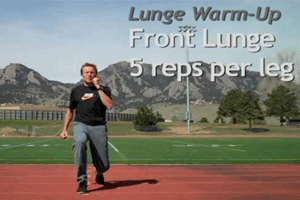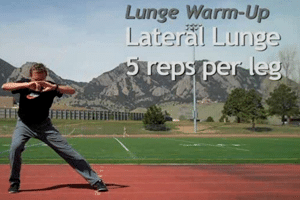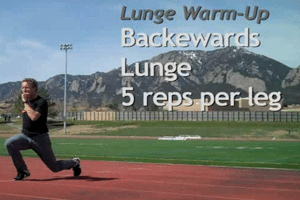While the benefits of stretching are hotly debated topic in running circles, I find a 5-10 minute active or dynamic stretching routine to be very good way to manage soreness and ward of injuries.
As a general rule, you should always stretch after a good warm-up or after your run. Never stretch cold muscles, as this may lead to injury. If you’re injured and can’t warm-up by running or cycling, heat any area you want to stretch or take a hot tub to heat the entire lower body.
What is Active Stretching?
These stretches are what we call active isolated stretching and influenced heavily by the work of Jim and Phil Wharton.
The underlying theory behind active isolated stretching is that if a muscle is stretched too far, too fast, or for too long, it elicits a protective action known as the myotatic reflex, causing it to automatically and ballistically recoil in an attempt to prevent the muscle from tearing. This occurs about three seconds into a stretch.
Therefore, with active stretching, you will hold a stretch for only a second or two, before the myotatic reflex kicks in. You will then relax the muscle and repeat 10 times for each body part. Using this technique, the muscles should exhibit a greater range of motion over the course of the 10 repetitions.
The other key to active stretching. is to contract the opposing muscles to allow the target muscle to relax. For example, when stretching the hamstrings, the quadriceps muscles on the front of the leg are contracted, relaxing the hamstrings and making them more susceptible to stretching.
This brings up the “assisted” aspect of active stretching. You will coax the muscle through the last few degrees of motion using a stretching rope or band that is wrapped around the foot or leg in various ways depending on the direction of the stretch (we will demonstrate exactly what you need to do with each stretch).
Active stretching routines
I recommend rotating between these three routines. If there is anything specifically bothering you, then you can also add that stretch into the mix.
Stretching I
1. Gastrocnemius – Repeat 8 to 10 times
2. Soleus – Repeat 8 to 10 times
3. Toe flexor – Repeat 8 to 10 times
4. Achilles – Repeat 8 to 10 times
5. Ankle – Repeat 8 to 10 times
6. Spinal extension – Repeat 8 to 10 times
7. Oblique flexion – Repeat 8 to 10 times
8. Spinal flexion – Repeat 8 to 10 times
Stretching II
1. Two-Joint Hip Flexor Stretch – Repeat 8 to 10 times
2. Piriformis – Repeat 8 to 10 times
3. Glutes – Repeat 8 to 10 times
4. Kneeling hip flexor – Repeat 8 to 10 times
5. Abductors – Repeat 8 to 10 times
6. Adductors – Repeat 8 to 10 times
Stretching III
1. Hamstring stretch – Repeat 8 to 10 times
2. Lower hamstring stretch – Repeat 8 to 10 times
3. Glutes – Repeat 8 to 10 times
4. Kneeling hip flexor – Repeat 8 to 10 times
5. Two-Joint Hip Flexor Stretch – Repeat 8 to 10 times
6. Gastrocnemius – Repeat 8 to 10 times
7. Soleus – Repeat 8 to 10 times
Dynamic warm-up
We recommend doing this quick, 5-minute warm-up routine before every run. This can be in addition to or in place of stretching. Often, I’ll do just this dynamic warm-up routine before an easy day and stretching after. On hard workout days, I’ll do both – the dynamic workout before starting the warm-up miles and active stretching before I begin the hard running.
1. Front Lunge

In this lunge, you are preparing for forwards & backwards movement (the sagittal plane). The front knee needs to stay in alignment with the front foot (same goes for back knee & back foot), but there is often debate as to whether the front knee should pass the toes. Personally, I see stopping the front knee from passing the toes as a way of helping quad dominant runners from using the posterior muscles more, discouraging excessive arching of the lower back and getting a better stretch in the all too often tight hip flexors.
2. Front lunge with a twist

The action of twisting over the front leg (moving your body through the transverse plane) increases the stretch in the hip flexor of the back leg. By challenging your balance it engages the core (including the glutes) and increases proprioception (your body’s ability to sense movement within joints and joint position). It will take some practice so break it down into stages.
3. Side lunge

This lunge moves your body through the frontal plane and in doing so targets the abductors and hip-stabilizing muscles. Aim to keep the fixed leg straight. Personally, I recommend rotating the lifted foot out to 45 degrees so that the knee moves in line with the foot.
4. Back and to the side Lunge

With this lunge, the traveling back foot turns 90 degrees to the side, again allowing the knee to move in alignment. By traveling in a combination of the frontal plane and sagittal plane, you are preparing for the often forgotten rotational demands of running.
5. Backward lunge

The backwards lunge is more challenging than the others but in essence involves the same muscle movement sequencing that is needed in running. It demands more core stability, hip extension and glute recruitment than the other lunges, decreasing hip and ankle stiffness. Or as Coach Jay says “…a great way to explain to your butt that you’re about to use it.”
More information and resources on stretching
If you’re interested in reading more about stretching, you can read some of our posts:
1. To stretch or not to stretch?
2. How to warm-up for a workout or race
3. Does stretching help reduce injuries?
4. Recovering from hard workouts
5. How does a dynamic warm-up (seen above) help prevent injuries?
6. Is Stretching Before Running Bad? Expand Your Concept of Flexibility to Improve as a Runner
I hope you enjoy the info, please let us know if you have any questions.
